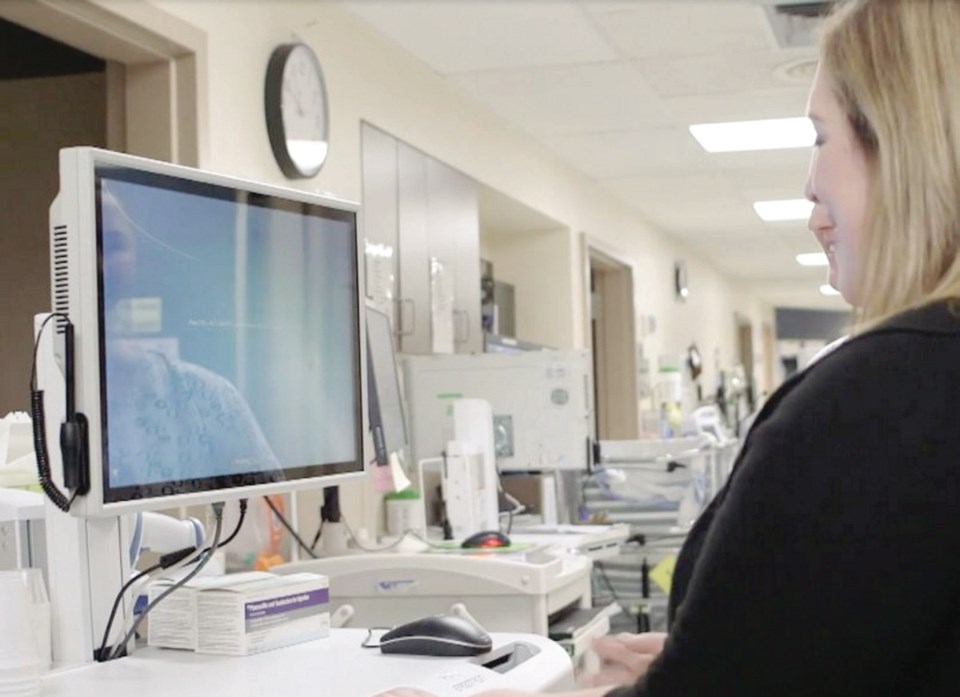A physician who spoke out against a problem-plagued electronic-health-record system at Nanaimo General Regional Hospital says pen and paper continue to be used in key departments nearly three years later.
“I don’t think anything substantially has changed,” said Dr. David Forrest, past president of the Nanaimo Medical Staff Association, which represents about 250 physicians.
Improvements to the hospital’s electronic health-record system, called IHealth, have “stalled,” intensive-care-unit doctors still use pen and paper for lab and drug orders and documentation — the ER department uses pen and paper for drugs — and inefficiencies continue, Forrest said.
“There continue to be tweaks to the system, so some things are better,” Forrest said.
“Overall, I don’t think the system is much different.”
He said doctors, nurses and other staff are resigned to using workarounds to improve efficiency.
Island Health, however, maintains staff attitudes and the ease of using Cerner’s electronic health record — which is continually being modified — have changed substantially.
Ben Williams, executive medical director for the Nanaimo area for Island Health, confirmed the ICU doesn’t order anything electronically, nor does the emergency department order medication electronically.
But everything else has changed — for the better, said Williams. “IHealth was all anyone complained about two years ago and the culture at the hospital was toxic.” Few talk about IHealth today, he said.
Williams said all hospitals will eventually move to electronic record-keeping because it’s safer for patient care.
But Forrest asked why, if that’s the case, there is still no plan to introduce it fully in Victoria three years after it was unveiled in Nanaimo.
B.C. Health Minister Adrian Dix said despite inheriting the poor implementation from the B.C. Liberal government and “a very challenging process” to stabilize it, the NDP government has dug in to solve the problems, and “some progress” has been made.
“I think it will be very difficult and has been very difficult for a project that is over-budget and hasn’t met expectations to drive forward on it,” Dix said. “A lot of people just wanted it abandoned but we have to proceed.”
Dix said the next step is applying lessons learned in Nanaimo to other communities as IHealth is expanded, “which is obviously not just an expensive project but an important project to other communities.”
Implementation of the electronic health-record system Island-wide is expected to cost at least an additional $54.1 million, according to a review conducted by Ernst and Young.
Dix credited any progress being made in the electronic health record to those practising medicine in Nanaimo — doctors, nurses, health-sciences professionals and health-care workers.
“The IHealth project continues — the question is, where is the next site and where do we bring it forward?” Dix said.
The location of the next acute-care site for full implementation has not been decided upon, Island Health spokeswoman Cheryl Bloxham said in an email.
IHealth was launched in March 2016 at NRGH, Dufferin Place residential care centre in Nanaimo and Oceanside Health Centre in Parksville.
It was heralded as the first system in the province to connect all acute-care and diagnostic services through one electronic patient medical record, the first fully integrated electronic chart in the province.
Nine weeks after implementation, doctors in the intensive care and emergency departments voiced concerns about patient safety and reverted to pen and paper orders for medicine and tests such as X-rays and blood work.
Since then, two independent reports on the Cerner system have been conducted: The first was ordered by the B.C. Liberals in July 2016 and conducted by Dr Doug Cochrane. A second was ordered by the NDP in September 2017 and conducted by Ernst and Young.
(A third report on culture by Vector Group, requested by Island Health, said NRGH was failing in the management of its workers, who were complaining about bullying, secrecy and retaliation.)
Both B.C.-government ordered reports recommended stabilizing the system in Nanaimo before implementing it in another hospital.
In spring 2018, mediators Jane Morley and Jean Greatbatch, and Ernst and Young’s John Bethel completed a guide to implement the recommendations from Ernst and Young.
With the goal of stabilizing the system, Island Health, physicians and staff came up with 12 stabilization criteria condensed into seven workplans in the areas of: electronic health-record performance, devices and workspaces; patient documentation; clinician and staff capacity; emergency department and intensive care unit; medical administration record; system issues, changes and improvements, and education training and knowledge translation.
Stabalization will be achieved when improvements in the use and function of the electronic health record are part of day-to- day operations at Island Health, said Williams.
Dr. David Coupland, a radiologist and president of the Nanaimo Medical Staff Engagement Society, said a full stabilization update from the health authority will give a better indication of success and failures.
Coupland said the limitations of the IHealth system mean it won’t ever be fully functional for all departments.
“Overall, it’s improving and more and more people are finding they can cope with it,” Coupland said.
“Lessons have been learned, so I think it will be far better implemented with far less pain in the future.”
Coupland said he’s cautiously optimistic improvements will continue and the system will be fully functional one day: “It’s heading in the right direction.”
The Nanaimo hospital’s radiology department was digitized back in 2003 and “works well for us,” using some Cerner software and other software, he said. Radiology hasn’t experienced the problems the ICU physicians have encountered, he said, in part because radiology processes a lower volume of orders in more controlled circumstances.
In November 2018, the NDP government announced a new ICU will be completed in 2021 at the hospital.
Forrest said he can’t imagine there’s enough physical space in the current ICU to accommodate electronic health-record equipment.
Coupland said the expectation is it will be implemented prior to the construction of the new space in 2021. “That’s definitely the plan,” he said.



